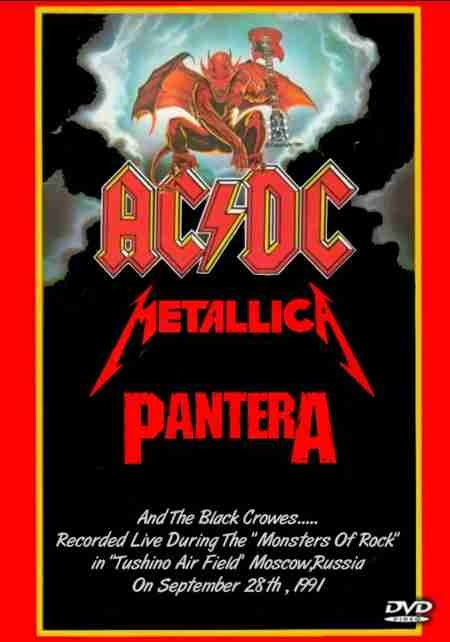What if I told you that one of the largest crowds to ever attend a concert—1.5 million people—happened in Russia?1 What if I told you that it was just before the fall of the Soviet Union? What if I told you that it was a heavy metal festival? Yes, this all happened in the fall of 1991, the very same year that the Iron Curtain fell. This is the story of the Monsters of Rock Moscow show.
The whole Monsters of Rock idea started in Castle Donington, England in 1980, gaining a monumental following in the following years, adding more popular bands in the rock and metal scene to the lineup. Although it was originally going to be a one-time event, over the next decade, the show was held again, and it only increased in popularity. It put on shows across Europe, cementing its place in music history.2

At the same time that Monsters of Rock was happening in Europe, the Soviet Union was in turmoil. During the 1980’s, Soviet Premier Lenoid Brezhnev died and by 1985, Mikhail Gorbachev had come to power. The Berlin Wall came down in 1989. Throughout the decade of the 1980s, western music was making its way into the USSR.
September 1991 was a big month in Russia. There was an August Coup, which was a failed military takeover of the Soviet Union.3 So, tensions were still high when the Russian government contacted the organizers of the show to see if they would be interested in having a show in Russia. Word of the show spread to many outlets, who wanted to see if they could televise the event, with Time Warner ending up getting the rights to record the show.

When it came to selecting the bands to perform, it was difficult to choose which bands would go. Because of Soviet isolation, the festival organizers did not know which bands would be popular in Russia. So, some of the most popular metal bands were chosen, bands such as AC/DC, Metallica, and Pantera, which became the main headliners for the show.4 The date for the event was set for September 28, in Tushino Airfield, a former site of Soviet military exercises.
On the day of the event, a flood of people came into the airfield early in the day, with events starting off at 2 p.m. with Pantera preforming first. The recordings of Pantera’s set can be seen online, capturing the loud and energetic atmosphere that the band was able to generate on their audience. The set that is remembered the most out of this event is Metallica’s. It was here that the estimated 1.5 million people showed up, causing chaos for the Soviet guards who were at the event.5 Video footage shows helicopters flying close to the crowd, trying to settle down the rowdy fans. In a video of the set, one can see the ocean of people moving around and singing along, even though the majority of the crowd only knew English through the music. You can feel the raw emotions of the crowd and see how one simple music event was able to draw in over 1.5 million, all through the power of music.

In December of 1991, a few months after the show had happened, the official dissolution of the Soviet Union took place.6 Many of the many restrictions on western media and music were gone and more events like the Monsters of Rock show were able to take place in the country. The legacy of the show is still known today. What was once thought of as a risk turned out to be one of the largest attended shows in history. It is truly beautiful how music was able to do this in a country where many restrictions on media did not allow this.
- Nathan Smith, “No Fences: Garth Brooks & the Fuzzy Math of 10 Mega-Concerts,” Houston Press, May 23, 2016, https://www.houstonpress.com/music/no-fences-garth-brooks-and-the-fuzzy-math-of-10-mega-concerts-6776412 . ↵
- Matt Wilkinson, “Plaque in Honour of Monsters Of Rock Co-founder Presented at Download.” NME, June 14, 2010, https://www.nme.com/news/music/download-festival-9-1291987 . ↵
- Jamie Glazov, “The Collapse of the Soviet Union: 25 Years Later,” Frontpage Magazine, December 26, 2016, https://www.frontpagemag.com/fpm/265260/collapse-soviet-union-25-years-later-jamie-glazov . ↵
- Nathan Smith, “No Fences: Garth Brooks & the Fuzzy Math of 10 Mega-Concerts.” Houston Press, May 23, 2016, https://www.houstonpress.com/music/no-fences-garth-brooks-and-the-fuzzy-math-of-10-mega-concerts-6776412 . ↵
- Brian Bumbery, “Metallica’s “Black Album” Sets New Sales Record,” Globe Newswire News Room, May 29, 2014, https://globenewswire.com/news-release/2014/05/29/1002715/0/en/Metallica-s-Black-Album-Sets-New-Sales-Record.html/ . ↵
- Jamie Glazov, “The Collapse of the Soviet Union: 25 Years Later,” Frontpage Magazine, December 26, 2016, https://www.frontpagemag.com/fpm/265260/collapse-soviet-union-25-years-later-jamie-glazov . ↵



53 comments
Samantha Luckey
This is a fun and interesting article regarding a wonderful event. This short and brief article was able to illustrate the how certain moments can become historical bookmarks. This author was able to establish a historical background that engaged the reader to continue reading on, shocking the reader into showing how a oppressed country could allow something like music to breach their borders.
Natalie Thamm
This was a really cool article that did a great job of meshing music with more traditionally historic events (Berlin Wall falling, dissolution of USSR). I would have never had guessed that an even such as metal concert could draw so many people, let alone in a country as isolated as the USSR during this time. It really shows just how much music can bring together people.
Dylan Sanchez
I never knew Metallica played in the Soviet Union. I didn’t even know they allowed anything remotely western in the Soviet Union. It’s great to read that the spirit of music travels through all of the world even with boundaries. I wonder if this had an influence on the people to walk away from communism and become free. Thanks, Metallica.
Jasmine Rocha
It was really interesting reading this article because it showed how music is very influential. I learned how one of the biggest metal concerts was held in Russia with around 1.5 million people attending. ACDC made a big impact on both the people in the concert as they were performing but also those outside the concert because it was broadcasted live.
Hailey Stewart
I recently watched the movie Bohemian Rhapsody and this concert echos the vibes of the Live Aid concert that Queen was a part of. I would have never guessed that a concert of that size and genre would have happened in Russia at that particular time in history. It is so neat to see how people can come together through music even and especially during hard times.
Daniel Linstead
The music industry is one of the biggest things that bring people together. It connects to peoples emotions and brings the world together with powerful messages. I found it amazing that one concert could bring in 1.5 million people. It is amazing to think that music has the ability to bring that many people together. Good article to read and was enjoyable.
Richard Morales
This article was very interesting as I had never heard of this concert before. Although the article was not very lengthy it provided sufficient information about the ‘Monsters of Rock’ concert. I was shocked to learn that the audience exceeded 1.5 million, in a state as conservative as Soviet Russia. I was surprised to learn that Time Warner was able to televise the event, given how isolated the Soviet Russian government was at the time.
Martina Rodriguez
While I consider myself to be a music fan, and a particular fan of all the bands mentioned, I have to admit I’ve never heard of this show before. What an interesting topic to write about! I’ve personally been to a Metallica concert before and had the extreme luck to be very close to the stage, so I am not surprised in the slightest that helicopters were needed to calm the crowds down…they can get REALLY wild. I really loved how a video link was included in the end!
Megan Copeland
This was a very interesting article to read. I never knew that the largest crowd to attend a concert was 1.5 million people. I also never new it happened in Russia. It must be so cool for the performers to look out into the crowd and see that many people there just for them singing their songs. This event set a standard for other bands to look towards, and show them that anything is possible.
Donte Joseph
The power of music is something that still amazes me to this day. For starters I had always assumed that Soviet Russia was more private and conservative so reading how they allowed metal bands to perform for them, and even enjoyed it is astonishing to me. Additionally, I was more surprised that Time Warner was able to secure rights to broadcast this event. Overall, this article was short but sweet and I am glad I took the time to learn more about history.